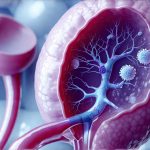Experiencing a flare while on hormone therapy can be incredibly unsettling, triggering anxiety and uncertainty about your body and treatment plan. It’s important to remember that flares are not uncommon – they’re often an expected part of managing chronic conditions and navigating the complexities of hormonal transitions. A “flare” in this context refers to a temporary worsening of symptoms related to the condition being managed by hormone therapy, such as gender dysphoria, autoimmune diseases, or other health issues where hormones play a key role. Understanding what causes these flares, how they might manifest differently while on hormones, and what steps you can take to manage them is crucial for maintaining your well-being during this process.
Hormone therapy itself doesn’t necessarily prevent flares; rather, it aims to modulate the underlying condition and reduce their frequency or severity over time. However, hormonal changes can sometimes interact with flare triggers in unpredictable ways. This means a flare might feel different than before starting hormones, or it might be triggered by something that never bothered you previously. It’s vital to maintain open communication with your healthcare team – endocrinologists, therapists, and other specialists – throughout this journey so they can help you navigate these fluctuations and adjust your treatment plan as needed. This article will explore what to expect during a flare while on hormone therapy, offering insights into potential causes, symptoms, management strategies, and when to seek additional support.
Understanding Flares & Hormone Therapy
Flares are essentially periods where the underlying condition being managed by hormones becomes more active or symptomatic. For example, in gender-affirming care, a flare might involve increased feelings of dysphoria, even after significant progress with hormone therapy. In autoimmune conditions, it could manifest as an increase in inflammation and associated symptoms. The triggers for flares are often multifactorial, meaning they’re rarely caused by a single thing. Common contributors include: – Stress, both physical and emotional – Changes in lifestyle or routine – Illnesses like colds or infections – Environmental factors (allergens, weather changes) – Hormonal fluctuations, even within the context of hormone therapy
The impact of hormone therapy on flares is complex. While hormones aim to stabilize the underlying condition, the process of hormonal adjustment itself can be disruptive. Initial stages of HRT may involve significant shifts in hormone levels, potentially triggering or exacerbating symptoms temporarily. Furthermore, the body’s response to hormones isn’t always linear; there can be periods where hormone levels seem stable but symptoms still fluctuate. It’s important to remember that hormone therapy is a long-term process and finding the right dosage and regimen often requires adjustments over time. A flare doesn’t automatically mean your hormone therapy isn’t working – it could simply signal the need for reevaluation or fine-tuning with your healthcare provider. Understanding female urethral exams can also provide a basis of understanding your body and potential hormonal interactions.
Finally, recognizing that flares are normal can be incredibly helpful. They don’t signify failure, but rather a temporary setback within a larger process of healing and management. Viewing them as opportunities to learn more about your body and refine your treatment plan can reduce anxiety and empower you to take proactive steps towards well-being.
Symptoms & Manifestations During Hormone Therapy
The symptoms experienced during a flare will vary significantly depending on the underlying condition being managed, the type of hormone therapy you’re receiving, and individual factors. However, some common themes emerge when navigating flares while on hormones. For individuals undergoing gender-affirming care, a flare might involve: – Increased feelings of dysphoria related to body image or social presentation – Heightened anxiety or depression linked to gender identity – A resurgence of previous discomfort with physical characteristics
In autoimmune conditions, a flare could present as: – Increased pain and inflammation in affected areas – Fatigue and weakness – Worsening skin rashes or other visible symptoms – Digestive issues – Flu-like symptoms. Importantly, these symptoms may feel different on hormone therapy because hormones can influence how the body perceives and responds to pain, inflammation, and emotional distress. For instance, estrogen therapy might alter pain thresholds or impact mood regulation, leading to a more intense or prolonged flare experience. When experiencing discomfort it’s helpful to understand prostate exams and the potential impact on hormone levels.
It’s also crucial to be aware of potential psychological impacts. Flares can trigger feelings of hopelessness, frustration, and self-doubt. The disruption to daily life and the uncertainty surrounding symptom management can significantly impact mental health. Therefore, prioritizing mental well-being during flares is essential – this might involve seeking support from a therapist, practicing mindfulness techniques, or engaging in activities that promote relaxation and stress reduction.
Identifying Flare Triggers
Pinpointing your individual flare triggers is key to proactive management. Keeping a symptom diary can be incredibly helpful for identifying patterns and correlations between your experiences and potential contributing factors. Record: – Dates and severity of flares – Specific symptoms experienced – Potential stressors or events leading up to the flare – Dietary changes, exercise routines, or sleep patterns – Environmental factors (allergens, weather)
This information will allow you and your healthcare team to identify common themes and develop strategies for minimizing exposure to triggers. For example, if stress is a major trigger, you might explore stress management techniques like meditation, yoga, or therapy. If dietary changes seem to correlate with flares, you may consider working with a nutritionist to optimize your diet. It’s important to note that triggers can be cumulative; it’s not always one single event but rather a combination of factors that leads to a flare.
Recognizing the Difference Between Flare & Side Effects
Distinguishing between a flare and side effects from hormone therapy can sometimes be challenging. Side effects are predictable, often dose-dependent reactions to the medication itself, while flares represent a resurgence of underlying condition symptoms. For example, weight gain is a common side effect of some hormone therapies, but it wouldn’t constitute a flare. However, increased joint pain in someone with an autoimmune condition would be considered a flare.
If you’re unsure whether your symptoms are due to a flare or a side effect, consult your healthcare provider. They can help assess the situation and determine the appropriate course of action. Sometimes, adjusting your hormone dosage or adding supportive medications can alleviate side effects without exacerbating the underlying condition. Remember, open communication with your medical team is essential for navigating these complexities. Understanding what to expect during a uroflowmetry procedure can also help differentiate between normal hormonal fluctuations and flare symptoms.
Managing Flares: A Step-by-Step Approach
Successfully managing a flare requires a proactive and multi-faceted approach. Here’s a step-by-step guide: 1. Acknowledge the Flare: Recognize that it’s happening and avoid self-blame. 2. Self-Care First: Prioritize rest, hydration, and nourishing foods. Avoid overexertion and prioritize activities that promote relaxation. 3. Symptom Management: Utilize strategies recommended by your healthcare team to address specific symptoms (e.g., pain medication, anti-inflammatory creams). 4. Communicate with Your Healthcare Team: Inform them about the flare, its severity, and any changes in your symptoms or triggers. They may recommend adjustments to your hormone therapy or other treatments. 5. Monitor & Document: Continue tracking your symptoms and triggers to refine your management plan.
Beyond these steps, consider incorporating supportive therapies like: – Mindfulness meditation for stress reduction – Gentle exercise (yoga, walking) to improve mood and energy levels – Social support from friends, family, or support groups – Creative outlets (art, music, writing) for emotional expression Remember that flares are temporary. While they can be challenging, they don’t define your journey or diminish your progress. With proactive management and a strong support system, you can navigate these setbacks and continue towards improved well-being.





















